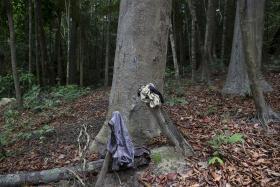Exhuming history
A Greek national developed such a strong fascination with local history that he wrote a book about it. NATASHA MEAH (natmeah@sph.com.sg) speaks to the author and shares some of his more unusual stories
It all started with a news report about Bukit Brown cemetery.
Greek national Kostas Ikonomopoulos, 39, was fascinated by the decision to build a highway and eventually a new town over the cemetery.
Mr Ikonomopoulos, a permanent resident here, said he took on the challenge of uncovering Singapore's hidden past through unexplored places, including cemeteries.
For six months, he trekked around Singapore, including the surrounding islands.
He visited up to 30 locations, including more than 15 cemeteries.
He walked alone along rows of headstones. He rubbed dirt off the stones with his bare hands to uncover the names engraved beneath as mosquitoes feasted on him.
At each cemetery, Mr Ikonomopoulos would take pictures and notes and examine the state of the grave.
He would pay close attention to some names that grabbed his attention and then study the architecture of the place.
His mission?
To find out who these people were and what their lives were back then.
He searched the National Archives of Singapore at the National Library Board, reading through both Malay and English newspapers to uncover stories and truths of the lives of people long forgotten.
Mr Ikonomopoulos, who moved here in 2010 and lives with his Singaporean wife and daughter, said: "People have a skewed perception of Singapore. They think Singapore is just Orchard Road and those who come here from other places think it's just a place to make money.
"It seems that the focus of society is on the technical and material progress and the fact that country also has a cultural past gets overlooked."
KRANJI BARRACKS
For example, he said, the old military barracks in Kranji where the British used to station the soldiers during colonial times have been demolished or repainted a very bright white and now house banks and other enterprises.
Things like colonial bungalows were also demolished to make way for high-rise buildings, he said.
So he decided to write a book to capture the cultural past that would otherwise disappear.
Remains: A Singapore Journey was released on Sept 10.
Remains: A Singapore Journey by Kostas Ikonomopoulos
WHAT
Book on Singapore's cultural past
PRICE
$19.26 inclusive of GST
WHERE TO BUY
- Online at www.ethosbooks.com.sg/
- Booktique at CityLink Mall
- Books Kinokuniya
Tales from the crypt

John M. Ottoson
The Japanese Cemetery Park (JCP) houses the remains of Japanese prostitutes and the ashes of John M. Ottoson, a castaway who became the first recorded Japanese in Singapore.
In 1833, when Ottoson - born Yamamoto Otokichi - was 14, he served as a sailor aboard the Hojunmaru.
A typhoon carried the ship off course and into the Pacific Ocean. They finally landed at Cape Alava in Oregon, North America.
He was taken to England and then went on to Macau, Okinawa, New York, Canton and Shanghai before ending up in Singapore.
He is reportedly the first Japanese to have lived in Singapore and, with his death, the first one to have died here.
After his remains were exhumed from the Choa Chu Kang Cemetery in 2004, his ashes were taken to the JCP and housed there.
Japanese rubber tycoon and brothel owner Tagajiro Fukaki donated part of his plantation to be used as a burial ground for young destitute Japanese prostitutes who died here in the 1890s.
During World War II, the cemetery was used to bury civilians and soldiers.

Vivian Tyrell
A major of the Royal Army Service Corps (RASC) rests in the Kranji Commonwealth Cemetery.
Sir Vivian Tyrell shot himself in the head in 1952 at Pulau Brani, off the southern coast of Singapore, where the RASC had its base.
He was supposed to appear before a court martial the next Friday but as his friend was helping him write some letters, he went up to his room to grab his pistol and dashed into the bathroom.
He shot himself as his friend opened the door.

Marcus Canagasabey
Mr Marcus Canagasabey, whose body lies in Choa Chu Kang cemetery, was one of the early pioneers of long-distance motoring.
In 1929, he drove from Singapore to London, an eight-month journey through India, Afghanistan, Persia, Iraq, Syria, the Balkans and Central Europe.
Mr Canagasabey and his friends braved the elements, driving a Morris-Cowley car through snow, mud and desert.

Ada Latham
Ms Ada Latham, who was the wife of a ship broker, was buried here after dying on a boat between Aden in Yemen and the Suez Canal in 1898.
Besides losing his wife in 1898, Mr Harold Latham suffered numerous setbacks after moving to Singapore in 1879. He filed for bankruptcy in 1908, went to trial for criminal breach of trust (CBT) in 1918 and died in 1922. Before his death, he sold his business to a Mr Ort, who found his share of setbacks.
Mr Ort was taken to court due to a dodgy commercial contract. He took to drink and ended up killing himself in 1923 after his wife left him.
Get The New Paper on your phone with the free TNP app. Download from the Apple App Store or Google Play Store now



